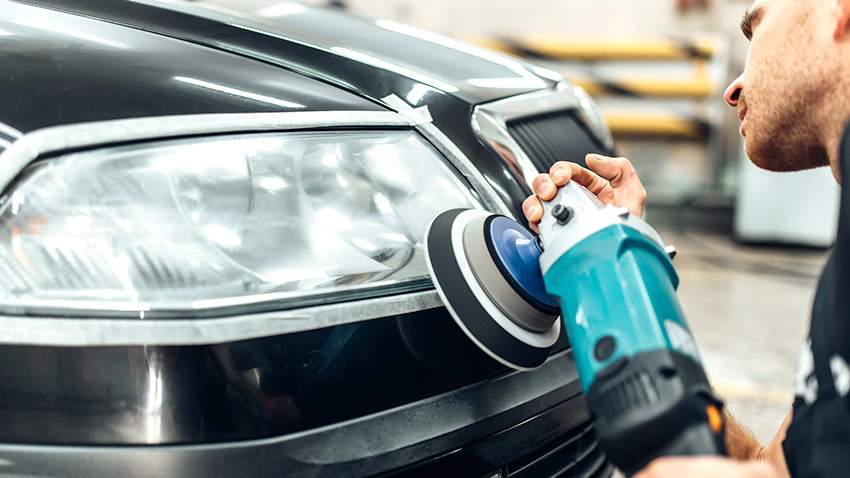
If your headlights have become dull or foggy, your car could fail its MOT. Here's how to restore dull headlights!
The problem
Over time, headlight glass can become discoloured or degraded by a number of things: oxidisation, moisture ingress, chemicals in airborne pollution; grit and dirt from road surfaces; ultraviolet radiation from sunlight; chemicals in raindrops and more. The effects of these can be so bad that they actually reduce the brightness of your headlights.
The issue is, as one might expect, more of a problem on older cars whose headlights may already be less bright than those of modern vehicles that use newer technology.
The Highway Code says we must use headlights when visibility is reduced to the extent that we can see less than 100 metres in front. We must also use headlights during the hours of darkness, which is defined as from half an hour after sunset until half an hour before sunrise.
If your headlights are so foggy or dim that they don't provide adequate illumination to enable you to see 100 metres in the dark, then you have a problem. If your headlight lenses are seriously affected, or your headlights don't deliver adequate light intensity, then your vehicle may fail its MOT test.
Restoring foggy or discoloured headlights
There are several ways to correct fogging on headlight lenses. Which you should choose depends on budget and how willing you are to roll up your sleeves and apply a bit of physical effort. Both professional and DIY fixes may deliver very good results.
Professional restoration
The simplest option and that most likely to achieve the best results, headlamp restoration is likely to cost between £35 and £50 per light. This may be higher for some luxury or high performance cars, or for vans and lorries.
The process is likely to take less than an hour and results are usually good. If there is a problem that can't be corrected by a standard process, a professional should be able to let you know and to explain your options.
DIY restoration with a specialist kit or product
There is a wide range of products available from well-known brands, such as T-Cut and others. These kits vary widely in their contents. Some contain a single product, usually a mild abrasive cleaner, while others contain abrasives, sealants or UV blocking compounds and polishing cloths or pads. As one would expect, these products come with instructions and, for many, instruction videos are available on YouTube.
A typical process might involve the following steps:
- Wash and dry the headlights thoroughly.
- Mask off paintwork around the light to prevent damage from substances used.
- Apply the abrasive and polish the glass with a cloth or pad, or with a polishing attachment for a drill or other suitable power tool.
- Apply the abrasive and polish the glass with a cloth or pad, or with a polishing attachment for a drill or other suitable power tool.
- Remove the polishing compound with a clean, dry cloth and wash and dry the headlight to assess the results.
- Repeat the polishing stage if necessary.
- Apply any sealant and/or UV protection compound that may be supplied.
This is just an example of a common process, and different kits and substances will require different application and removal methods. Some will require quite a lot of polishing while others may rely more on chemicals to break down stubborn dirt and residues.
We suggest checking reviews for products before buying and, if possible, watch videos showing the process and results. If a product is available from a brand you know and trust, maybe put that at the head of your list of products to look at.
DIY with household materials
It is quite possible to remove some, even all, of the fogging from headlight glass using just household items and ingredients. If you want to try this for yourself, it can be by far the least expensive solution.
Typical ingredients in DIY headlight cleaning and polishing compounds are baking soda, toothpaste (the kind containing baking soda), white vinegar and mildly abrasive cream cleaners like those sometimes used to clean porcelain and stainless steel etc in bathrooms and kitchens.
Here's one method for trying to clear your misted headlight glass with common household materials.
- Prepare your homemade polishing mixture. For example, mix baking soda into white vinegar or water until it forms a paste.
- Wash and dry the headlights thoroughly.
- Mask off paintwork around the light to prevent damage from substances used.
- Apply homemade paste and polish the glass well with a cloth or pad, or with a polishing attachment for a drill or other suitable power tool. This is likely to take longer than with a specialist kit from a retailer.
- Remove the paste with a clean, dry cloth and wash and dry the headlight to assess the results.
- Repeat the polishing stage if necessary.
- Wash the headlight well, especially if vinegar was used, as it contains acetic acid.
Bonus tip: a mixture of baking soda and vinegar also works well for cleaning stainless steel sinks and cooker hobs!
